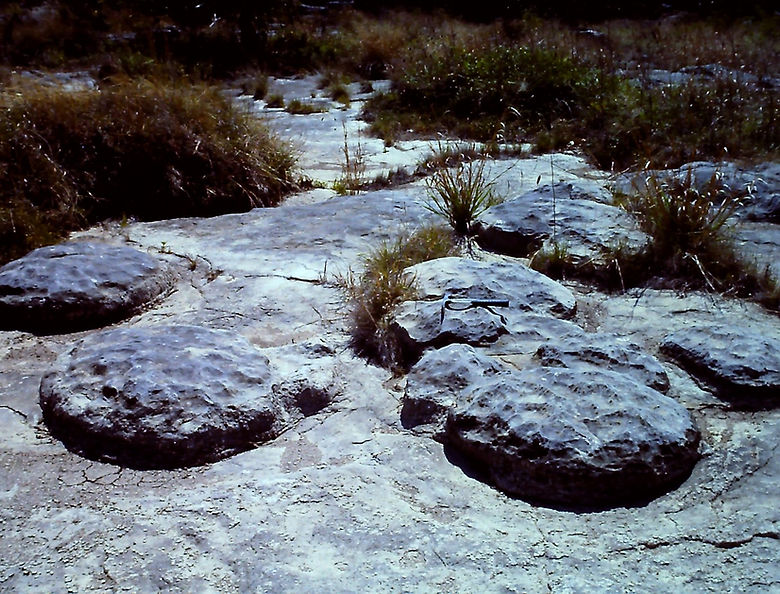
HONEYCUT BEND
FIELD TRIP STOP – HONEYCUT BEND (Ordovician Supratidal & Intertidal
Stromatolites)
LOCATION: Almost 5 miles east of Highway 281 near Johnson City, Texas. Here the Pedernales River loops south, coming close to Highway 2766. Access to the outcrop is through private property, so proper measures should be taken to access the outcrops.
GEOLOGIC FEATURES: Lower Ordovician Ellenberger Limestone (Honeycut Formation); Supratidal to Intertidal paleoenvironments; Stromatolites, Mudcracks, Intraclast
DESCRIPTION: At this site are bedding planes of Ordovician (Honeycut Fm.), and a clip exposing Devonian (Stribling Fm.), Mississippian (Ives Breccia), and Pennsylvanian (Marble Falls Limestone) strata. The most distinctive features of this locality are the stromatolitic mounds up to 3 ft. in diameter. In many cases they have differentially weathered leaving them to appear similar to modern-day stromatolites such as those seen in Shark Bay, Australia. The sediment around the mounds are mainly laminated lime mudstones. Associated mudcracks and tidal flat breccias (intraclasts) are also found along with gastropods.
STUDENT QUESTIONS:
(1) Look up a photo of modern-day stromatolites and compare them to the Ordovician ones seen at this outcrop.
(2) How are stromatolites thought to have been formed?
(3) How does Differential Weathering occur?
(4) Why are there no Silurian-aged rocks at this locality?
(5) How do the mudcracks and breccias support the paleoenvironment (supratidal and intertidal) existing here in the Ordovician?
(6) What geologic process(es) would account for the draping of sediment over a stromatolitic mound (see Fig. below).
(7) How are mudcracks formed in the fossil record and how does their presence suggest a particular paleoenvironment?
(8) How are the intraclasts (breccia) formed? What paleoenvironment does their presence suggest?
SELECTED REFERENCES:
-Barnes, V.E. et al. 1972. Geology of the Llano Region and Austin Area: Field Excursion. Bureau of Economic Geology, University of Texas at Austin. Guidebook 13, 77p.
PHOTOS:
_JPG.jpg)
Figure 1 - Differential weathering exposes stromatolitic mounds that existed near the shoreline of the Lower Ordovician sea in Central Texas.
_JPG.jpg)
Figure 2 - Lower Ordovician stromatolites of the Honeycut Formation. In the background is a cliff comprised of Devonian, Mississippian and Pennsylvanian strata.
_edited.jpg)
Figure 3 - A layer of Lower Ordovician stromatolite mounds stratigraphically overlain by lime mudstone.
_JPG.jpg)
Figure 4 - Overlying lime sediments drape over the underlying stromatolitic mound.
_JPG.jpg)
Figure 5 - Bedding plane view of Mudcracks suggestive of an intertidal environment within the Honeycut Formation of the Ellenburger Limestone.
_JPG.jpg)
Figure 6 - Bedding plane view of Intraclasts suggestive of an intertidal environment within the Honeycut Formation
_JPG.jpg)
Figure 7 - Cross-section of a bed illustrating Intraclasts within the Honeycut Formation.